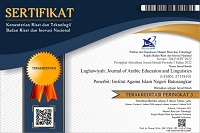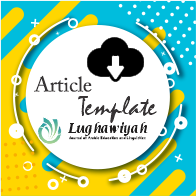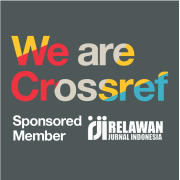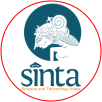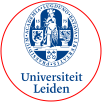CONSTRUCTION OF THE EQUATIVE INDEPENDENT CLAUSE IN THE ANECDOTE OF “JUHA WA AL-HISHAN AL-GHARIB” BY AHMED NAGUIB BASED ON KENNETH L. PIKE PERSPECTIVE / تدبير العبارة الفعلية المعادلة في حكاية "جحا والحصان الغريب" لأحمد نجب على أساس نظرية كينيت ل. بيك
Abstract
Keywords
Full Text:
PDFReferences
Ainin, M. (2013). Penelitian Pengembangan dalam Pembelajaran Bahasa Arab. Okara: Jurnal Bahasa Dan Sastra, 7(2), 95–110. https://doi.org/https://doi.org/10.19105/ojbs.v7i2.449
Arsyad, A. (2016). Teknik Interpretasi Linguistik dalam Penafsiran al-Qur’an. Jurnal Tafsere, 4(2), 165–178. https://journal.uin-alauddin.ac.id/index.php/tafsere/article/view/2770
Aspers, P., & Corte, U. (2019). What is Qualitative in Qualitative Research. Qualitative Sociology, 42, 139–160. https://doi.org/https://doi.org/10.1007/s11133-019-9413-7
Baker, C. F., & Ellsworth, M. (2017). Graph Methods for Multilingual FrameNets. Proceedings of TextGraphs-11: The Workshop on Graph-Based Methods for Natural Language Processing, 45–50. https://doi.org/10.18653/v1/W17-2406
Basid, A., Kamil, H. I., & Innah, M. (2021). Struktur Kalimat pada Film Knives Out Berdasarkan Perspektif Tata Bahasa Kasus Charles J. Fillmore. Diglosia: Jurnal Kajian Bahasa, Sastra, Dan Pengajarannya, 4(3), 301–320. https://doi.org/https://doi.org/10.30872/diglosia.v4i3.209
Basid, A., Syafina, H. I., Hayati, H., Nazir, H., & Razi, F. (2022). Bina Al-Jumal Al-Mu’aqqodah fi Riwayah “Ma La Nabuh Bih” ala Asasi Nadhriyyati Tagmemic Kenneth L. Pike. Okara: Jurnal Bahasa Dan Sastra, 16(2), 214–244. https://doi.org/10.19105/ojbs.v16i2.6024
Basid, A., Syahril, M., Muzakky, M. I., Muttaqin, I., & Imaduddin, M. F. (2022). Intransitive Independent Clauses in Film “Ḏīb”: Modern Linguistic Study Based on Kenneth L. Pike’s Tagmemic Perspective. Arabiyatuna: Jurnal Bahasa Arab, 6(2), 349–374. https://doi.org/http://dx.doi.org/10.29240/jba.v6i2.4240
Basri, H. (2011). An-Nahwu Al-Muyassar. Ma’had Dar al-Lughah wa al-Da’wah.
Bhat, A. (2018). Descriptive Research: Definition, Characteristics, Methods + Examples. QuestionPro. https://www.questionpro.com/blog/descriptive-research/
Chen, H., Yang, X., & Li, X. (2022). Learning a General Clause to Clause Relationships for Enhacing Emotion Cause Pair Extraction. Computation and Language. https://doi.org/https://doi.org/10.48550/arXiv.2208.13549
Damaskinidis, G. (2017). Qualitative Research and Subjective Impressions in Educational Contexs. American Journal of Educational Research, 5(12), 1228–1233. https://doi.org/10.12691/education-5-12-10
Darwin. (2017). Struktur Klausa Independen Bahasa Dondo. Bahasa Dan Sastra, 2(2), 25–38. http://jurnal.untad.ac.id/jurnal/index.php/BDS/article/view/12283
Doran, Y. J., & Bangga, L. A. (2022). Sundanese Nominal Groups: Meaning in Text. Meaning in Text, WORD, 68(2), 145–199. https://doi.org/https://doi.org/10.1080/00437956.2021.2024353
Edwards, B. L. (2006). Tagmemics. In Encyclopedia of Language & Linguistics (pp. 477–480). https://doi.org/10.1016/B0-08-044854-2/02052-6
Faisal, S. (1990). Penelitian Kualitatif: Dasar-Dasar dan Aplikasinya. Yayasan Asih Asah Asuh.
Fazal, F. A., & Chakravarty, R. (2019). Role of Library in research Support: a Study of Bharathiar University. Library Philisophy and Practice. https://doi.org/10.5281/zenodo.3477848
Gras, P., & Sansinena, M. S. (2017). Exclamatives in the Functional Typology of Insubordination: Evidence from Complement Insubordinate Constructions in Spanish. Journal of Pragmatics, 115, 21–36. https://doi.org/https://doi.org/10.1016/j.pragma.2017.04.005
Hoekstra, J. (2014). A well as I can/As I best can/As best as I can - Some Properties of Potentiality Equatives. Linguistics in the Netherlands, 31(1), 66–77. https://doi.org/https://doi.org/10.1075/avt.31.06hoe
Husin, A., & Husi, R. (2016). Peran Teori Tagmemik dalam Pembelajaran Sastra Anak Khususnya Penggunaan Media Lagu-Lagu Dolana. Jurnal Pusaka, 2(2), 68–78. https://doi.org/https://doi.org/10.35897/ps.v2i2.24
Jurafsky, D. (2014). Obituary: Charles J. Fillmore. Computational Linguistics, 40(3), 725–731. https://doi.org/10.1162/COLI_a_00201
Kotin, M. L. (2017). Unreal Conditional Clause and Independent Clause of Optative Condition: Problems of Grammatical Status. Voprosy Jazykoznanija: Topics in The Study of Language, 18(2), 1-9–130. https://doi.org/10.31857/S0373658X0000973-9
Lee, J. J. H. (2021). Kenneth Lee Pike’s Tagmemics and Its Discourse Analytic Implications for the Interpreatation of the New Tastament. In S. E. Porter & Z. K. Dawson (Eds.), Pillars in the History of Biblical Interpretation, Volume 3: Further Essays on Prevailing Methods (pp. 333–353). Wipf and Stock Publishers.
Leeder, C., & Shah, C. (2016). Library Research as Collaborative Information Seeking. Library & Information Science Research, 38(3), 202–211. https://doi.org/https://doi.org/10.1016/j.lisr.2016.08.001
Mack, N., Woodsong, C., MacQueen, K. M., Guest, G., & Namey, E. (2005). Qualitative Research Methods: A Data Collector’s Field Guide. Family Health International.
Matthiessen, C. M. I. M., & Yousefi, M. (2022). Systemic Functional Linguistics as a Resource for Teacher Education and Writing Development. Language, Context and Text, 4(1), 114–145. https://doi.org/https://doi.org/10.1075/langct.20005.mat
Muhartoyo. (2012). The Functional Slots of Finite Verb Tagmas. Binus Journal Publishing, 3(1), 70–80. https://doi.org/https://doi.org/10.21512/humaniora.v3i1.3235
Mutonga, L. (2023). Breaking Boundaries: Current Research Trends in Zimbabwean Linguistics—A Case of the University of Zimbabwe. In T. Marevesa, E. Jakaza, & E. Mavengano (Eds.), Multidisciplinary Knowledge Production and Research Methods in Sub-Saharan Africa (pp. 183–200). Palgrave Macmillan. https://doi.org/https://doi.org/10.1007/978-3-031-35531-8_12
Naguib, A. (2007). Juh}a> wa al-H{is}a>n al-Ghari>b. Dar Al-Kitab Al-Misry.
Pike, K. L. (1970). A Guide to Publication Related to Tagmemic Theory. In Theoretical Foundations. De Gruyter Mouton. https://doi.org/https://doi.org/10.1515/9783110814644-007
Pike, K. L. (1982). Linguistic Concepts: An Introduction to Tagmemics. University of Nebraska Press.
Pike, K. L., & Pike, E. G. (1982). Grammatical Analysis. The Summer Institute of Linguistics and The University of Texas at Arlington.
Poythress, V. (2022). A Semiotic Analysis of Multiple Systems of Logic: Using Tagmemic Theory to Assess The Usefulness and Limitations of Formal Logics, and to Produce a Mathematical Lattice Model Including Multiple Systems of Logic. Semiotica, 2022(244), 145–162. https://doi.org/https://doi.org/10.1515/sem-2020-0051
Poythress, V. S. (2021). Semiotic Analysis of Symbolic Logic Using Tagmemic Theory: With Implications for Analytic Philosophy. Semiotica, 2021(243), 171–186. https://doi.org/https://doi.org/10.1515/sem-2020-0018
Poythress, V. S. (2022). Multiple Perspectives in Semiotics, Illustrated with Tagmemic Analysis of Tic-Tac-Toe: With Implications for Artificial Intelligence. The American Journal of Semiotics, 38(1/4), 71–90. https://doi.org/https://doi.org/10.5840/ajs202342081
Rizki, R. B. (2020). Kajian Linguistik Modern Strukturalis dalam Pembelajaran Bahasa Arab. Alsina: Journal of Arabic Studies, 2(2), 173–188. https://doi.org/10.21580/alsina.2.2.4968
Sari, N., Saragih, A., & Pulungan, A. H. (2020). External and Internal Conjunctions in the News Story Text of the Jakarta Post. Linguistik Terapan, 17(1), 17–28. https://doi.org/https://doi.org/10.24114/lt.v17i1.19761
Soeparno. (1988). Penerapan Teori Tagmemik dalam Pengajaran Bahasa Indonesia. Cakrawala Pendidikan: Jurnal Ilmiah Pendidikan, 7(1), 5–15. https://doi.org/10.21831/cp.v1i1.7437
Syrett, K. (2015). QR Out of a Tensed Clayse: Evidence from Antecedent-Contained Deletion. Ratio, 28(4), 395–421. https://doi.org/https://doi.org/10.1111/rati.12107
Tarigan, H. G. (1980). Linguistik Kontrastif. FPBS IKIP.
Taylor, S. J., Bogdan, R., & DeVault, M. (2015). Introduction to Qualitative Research Methods: A Guidebook and Resource (4th ed.). John Wiley & Sons.
Thyer, B. A. (2001). The Handbook of Social Work Research Methods. SAGE Publications, Inc. https://doi.org/https://dx.doi.org/10.4135/9781412986182
Usman, A. (2015). Frase Nomina Bahasa Gorontalo. Kajian Linguistik, 3(1). https://doi.org/https://doi.org/10.35796/kaling.3.1.2015.8608
Wang, S., Thompson, L., & Iyyer, M. (2021). Phrase-BERT: Improved Phrase Embeddings from BERT with an Application to Corpus Exploration. Computation and Language. https://doi.org/https://doi.org/10.48550/arXiv.2109.06304
Widiastuti. (2018). Analisis Hubungan Antarklausa dari Segi Perilaku Hubungan Semantik pada Teks Akademik. Prosiding Seminar Nasional Dies Natalis UNM Ke 57, 393–400. http://eprints.unm.ac.id/id/eprint/11328
Zhan, H., Huang, S., & Sun, L. (2023). Paradigms as Second-Order Schemas in English Noun-Participle Compounding. Review of Cognitive Linguistics, 21(2), 542–575. https://doi.org/https://doi.org/10.1075/rcl.00147.zha
DOI: http://dx.doi.org/10.31958/lughawiyah.v5i2.9512
Refbacks
- There are currently no refbacks.

This work is licensed under a Creative Commons Attribution-NonCommercial 4.0 International License.
Lughawiyah Indexed By:

Lughawiyah distribute under Lisensi Creative Commons Atribusi-NonKomersial 4.0 Internasional.
View My Stats lughawiyah
